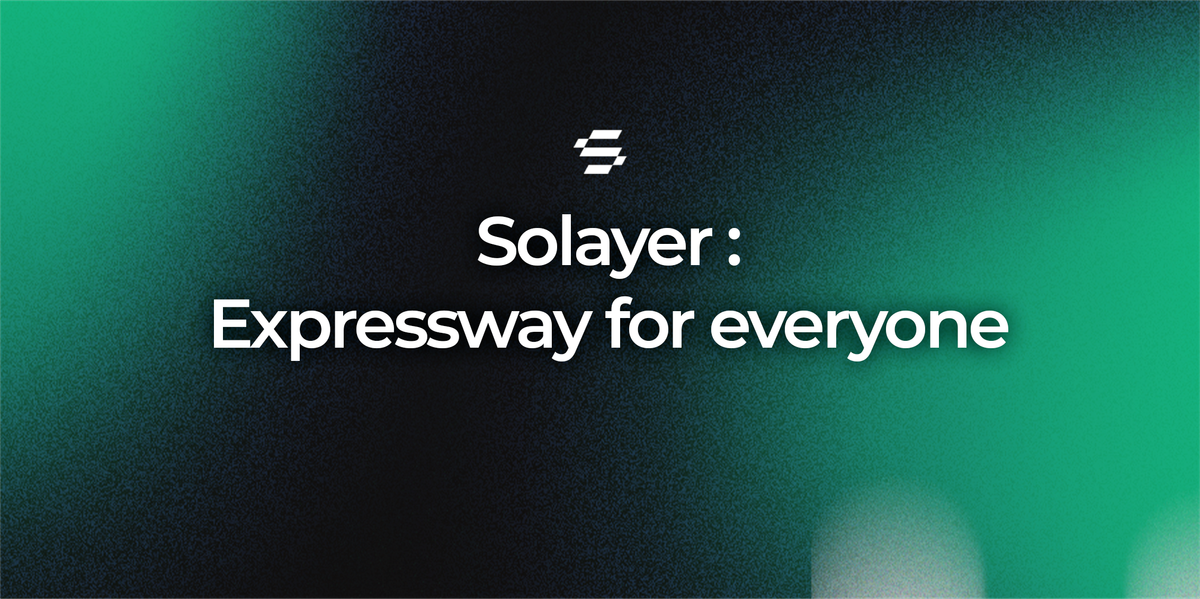
On July 28, Helius, with the largest staking on Solana, outpaced Galaxy by accounting for 3.4% of the total staking volume. They attract users with conditions that are unprecedented among their competitors: 0% validator commission and 0% MEV commission. Clearly, running a validator with 0% commission and providing hSOL is going to put some apparent financial strain on an RPC provider like Helius.
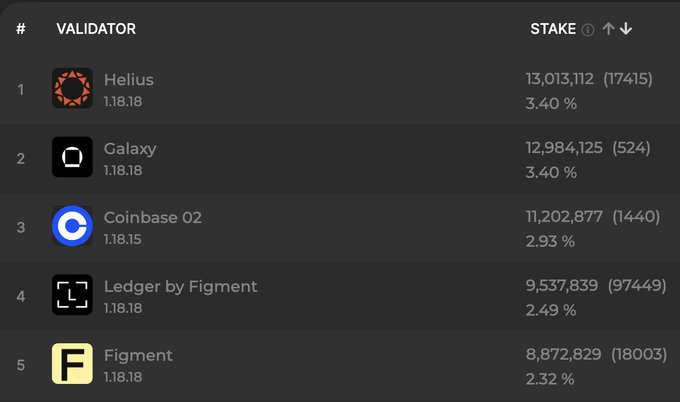
But why would Helius do this? Well, the answer lies in the performance of the RPC, which is directly proportional to the amount staked. To understand this, one needs to grasp two topics: how Solana's TPU processes transactions and what Stake Weighted Quality of Service (SWQoS) means.
In the article, we present SWQoS, its potential to engender network usage monopolies, and how Solayer uses elegance to resolve these challenges.
How Solana's TPU Gets Transactions
In the context of Solana, it touches on how precisely validators deal with arriving transactions. Assuming a transaction is sent from a client to a validator, once reaching the fetch stage, it has three possible paths: TPU, TPU Vote, and TPU Forwards.
- TPU - Transaction Processing Unit: It executes the majority of transactions in this socket.
- TPU Vote: This socket is responsible for handling vote transactions.
- TPU Forwards: This socket forwards those transactions that cannot be processed in the current slot to the next leader.
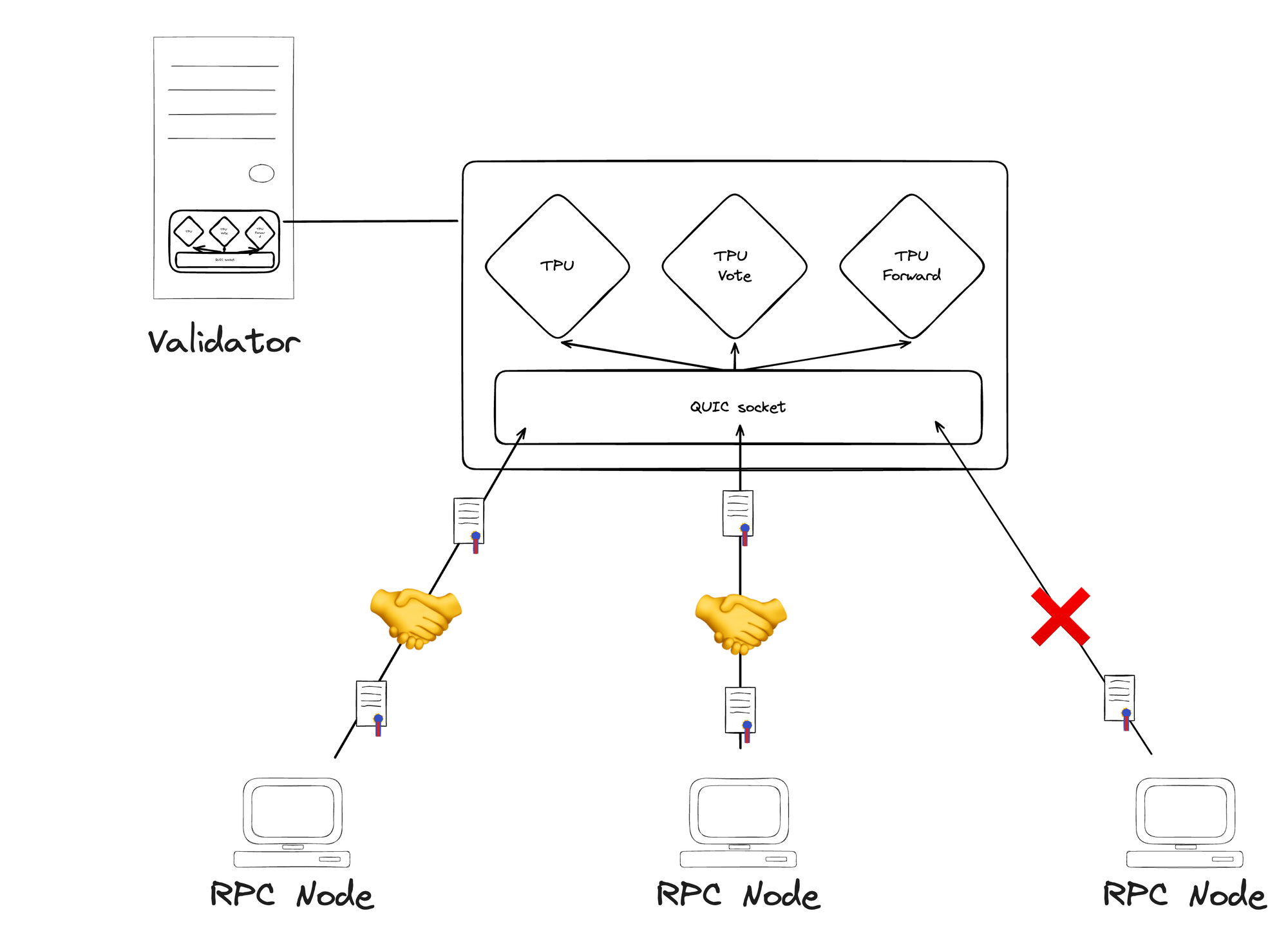
Through a communication protocol called QUIC, the TPU receives transactions from RPC nodes. It is through a QUIC connection that RPC nodes regularly send users’ transactions to the leader validator. After establishing the connection, the RPC node relays these transactions to the leader validator.
It's important to note that RPC nodes don't participate in Solana's consensus and are not staking any $SOL. A potential network performance degradation by means of spamming on the RPC nodes was countered by implementing QUIC between the RPC nodes and leader validators. This novel communication mechanism enables Solana to run one-of-a-kind experiments, further setting the network apart.
Emergence of SWQoS
While RPC nodes had to communicate with leader validators, the shift to QUIC from UDP increased the performance over the network. It was pretty hard to limit or filter out the communication packets with UDP, and, therefore, quite taxing to prohibit spamming, a lot alike DDoS attacks, on the Solana network, which has no mempool. A user thus had to fast-run transactions in order to hit the Leader Validator's TPU, and often many were before one finally went through.
This was exacerbated by Solana's low transaction fees, which failed to economically deter mass transaction submissions.
Switching to QUIC empowered the leader validators to disconnect from RPC nodes that appeared to be spamming transactions, hence keeping up the performance of the network. On the other hand, differentiation between an RPC node that was sending spam transactions and another one with actually high usage of the network was close to impossible without looking at the real packets at the TPU.
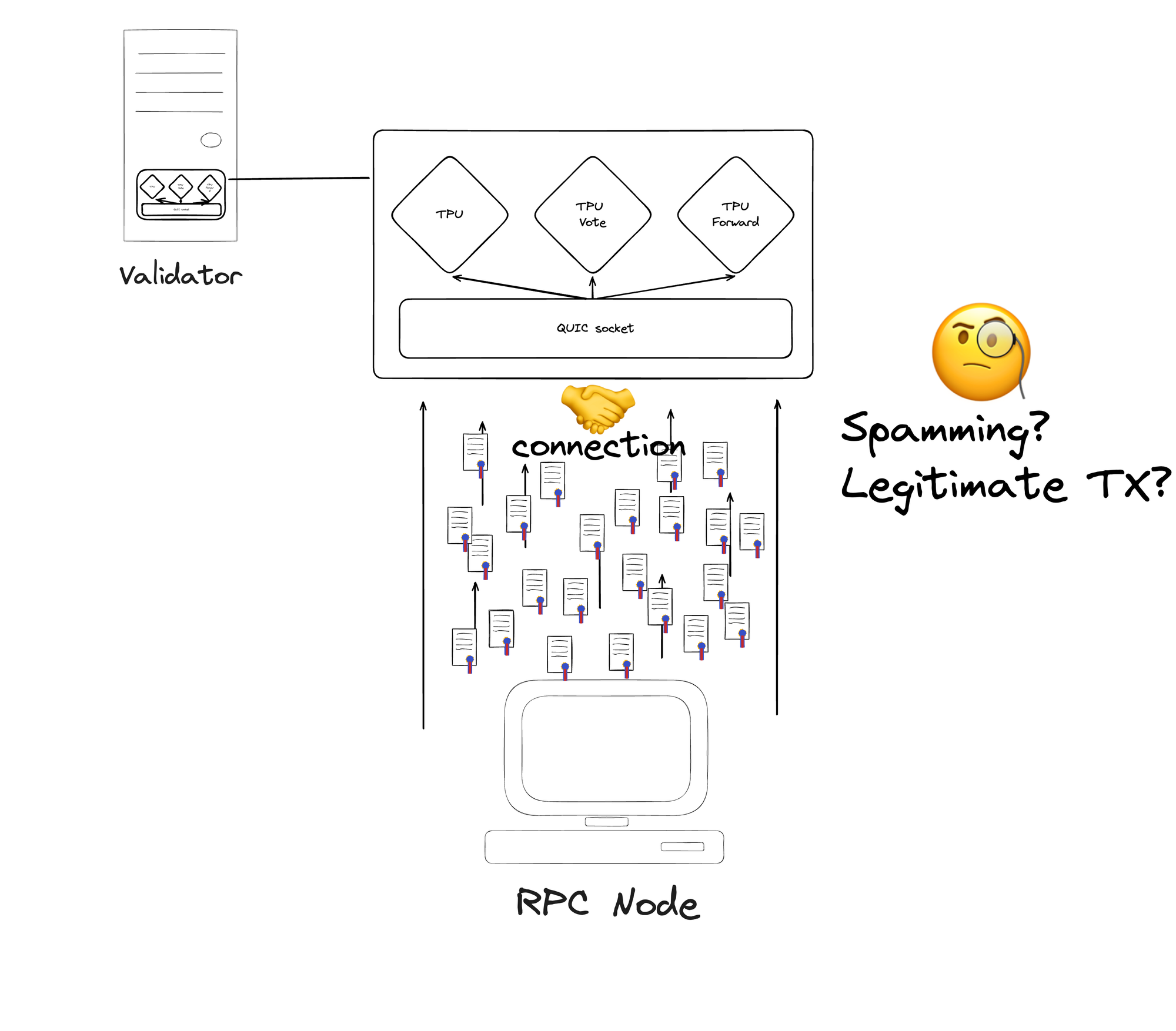
This need led to the development of Stake Weighted Quality of Service (SWQoS), with the intuition in mind that Solana's staked amount could be a metric to appraise RPC nodes. Trust in validators in a chain of this consensus is based on the staked amount and its economic security. Generalizing this trust to the RPC nodes, which deliver transactions to the very same validators, was laid as bedrock for SWQoS.
Details of SWQoS
A leader validator can create and receive transactions using 2,500 QUIC connections. From these connections, it reserves 500 for receiving transactions from any RPC node regardless of its stake. The remaining 2,000 are then divided in relation to the Solana that each Validator has staked versus the total staked Solana.

For instance, if there is a total stake of 1,000,000 $SOL and RPC node A has 100,000 $SOL staked, such an RPC node would then be able to secure 200 connections. Although RPC nodes cannot actually help in contributing to Solana's consensus, an RPC node is still able to hold a virtual stake through mutual peer connection with any of the validators. It is this virtual stake that will allow a leader validator to decide upon the number of connections that are required to be allocated to the RPC Node.
This will apply to rich, connection-limitation methods—used not only with the standard Solana validator client but also with the Jito Solana client's relayer. The RPC nodes connect as peers to a validator and send their transactions to their peer validator, which in turn forwards these transactions across to the leader validator. After that, using the virtue of virtual stake, those connections are distributed, and the leader validator is tasked with processing transactions.
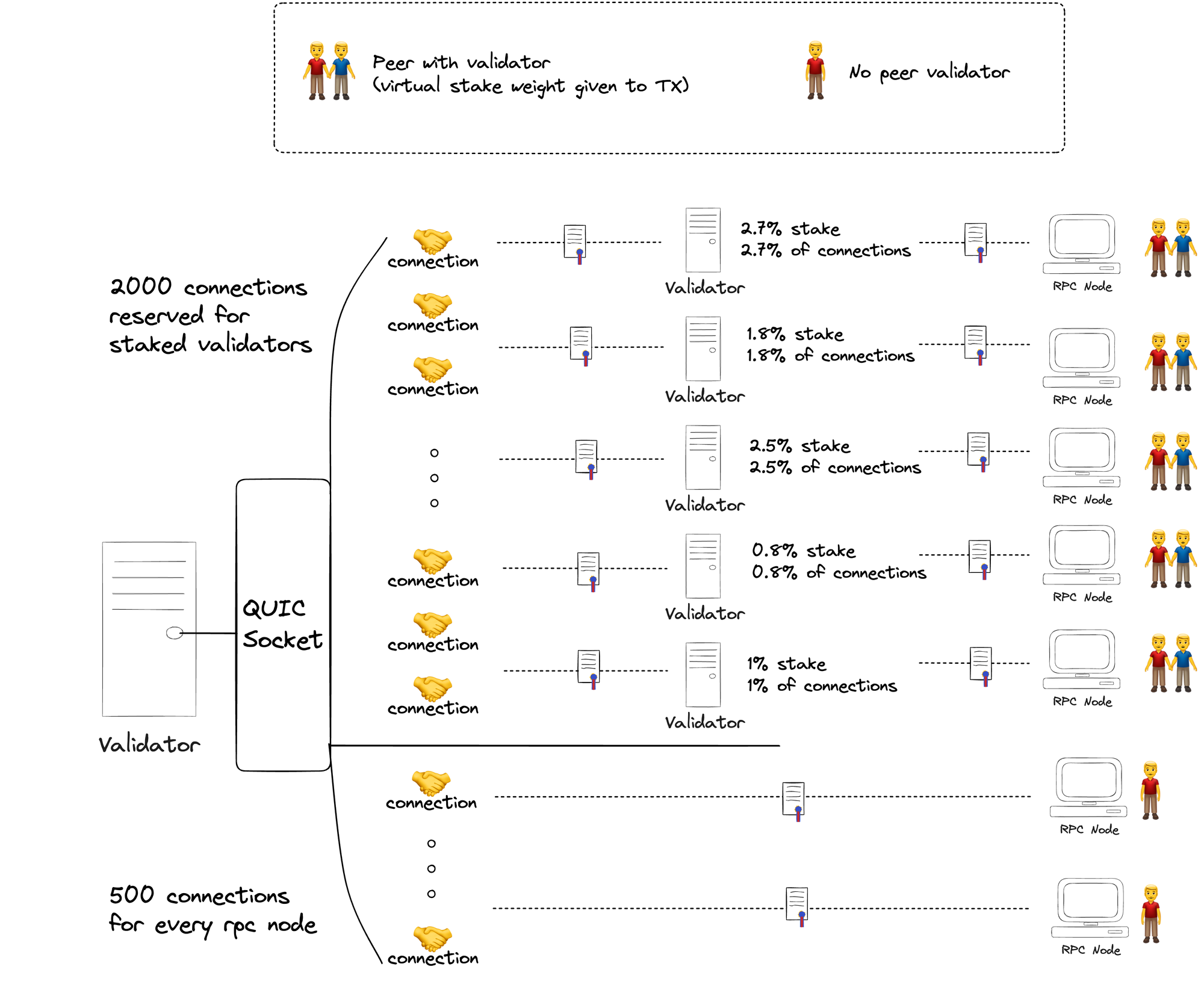
In this system, the leader validator is able to give priority to transactions that come from RPC nodes with substantial virtual stakes in order to make the network resilient to DDoS attacks and spamming. Since Helius stakes the most Solana within its validator, 3.4% of the bandwidth is guaranteed to be available. That is why Helius is working hard to secure a large amount of staking.
Tradeoff between Network Security and Permissionless Transaction Transmission
Prioritizing transactions from highly staked RPCs can lead to a situation where these RPCs pass on high costs to regular consumers. This scenario risks creating a quasi-permissioned environment where only transactions from peers of highly staked validators are prioritized. High-frequency trading and arbitrage firms might monopolize transaction execution, disadvantaging retail users who could face higher costs. In an extreme scenario, this could lead to a dystopian outcome where a few entities dominate network usage.
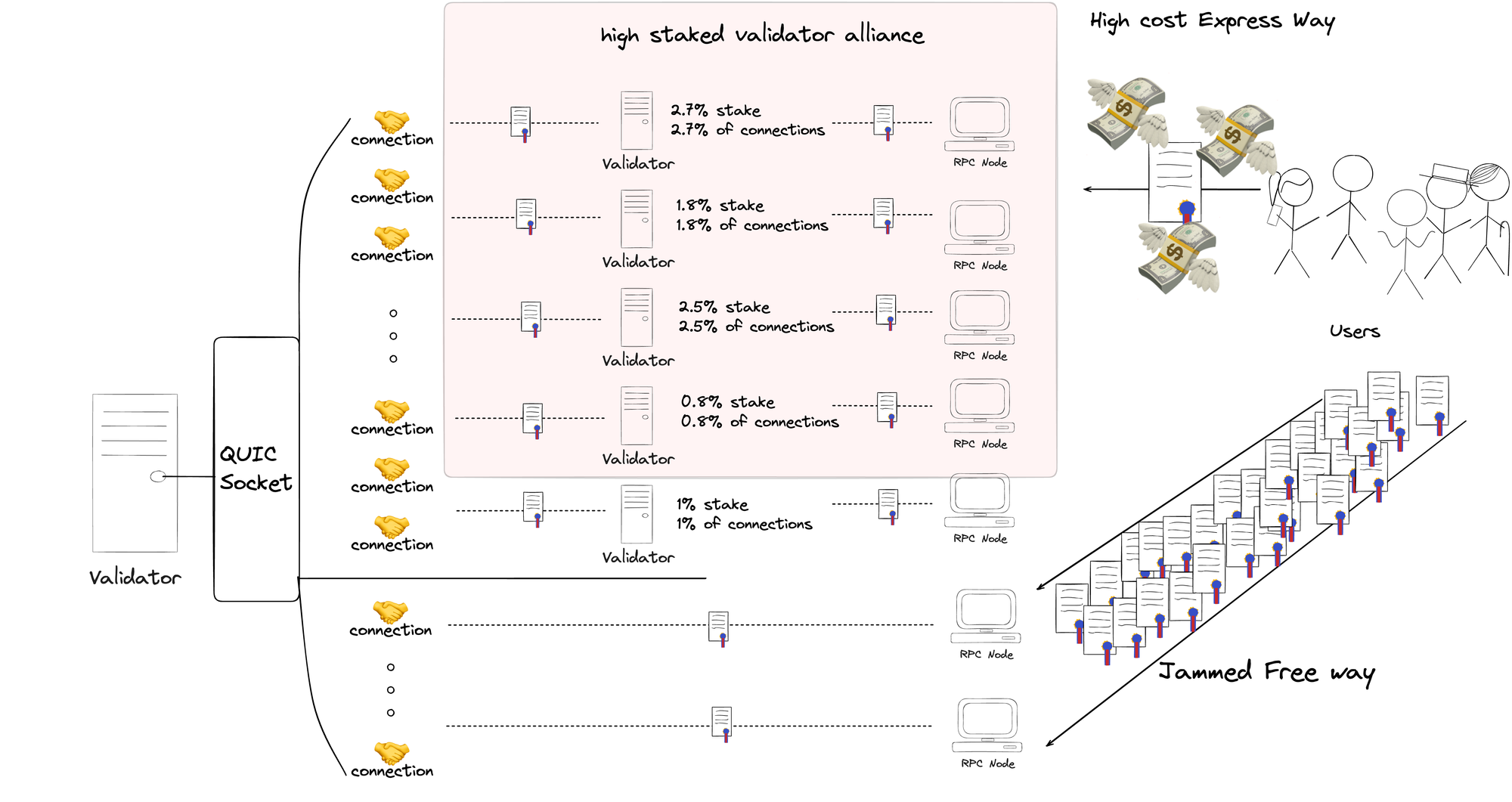
The peering process between validators and RPC nodes occurs off-chain, with validators evaluating and choosing RPC nodes to share their stake based on off-chain incentives. This could result in validators selecting RPC nodes that offer the most incentives, and RPC nodes prioritizing transactions that pay the highest fees.
Consequently, measures intended to enhance network security might inadvertently impose restrictions on network usage. While SWQoS aims to improve network stability and performance, it also carries the risk of accelerating network monopolization by a few groups, highlighting the delicate balance between maintaining security and ensuring permissionless transaction transmission.
Solayer
Solayer is the liquid staking token restaking platform. They accept staking from users who hold LST and SOL with a current value of 140 million dollars in Solana, and LST is also staked in the vault of Solayer. But all this is to restake for what? Restaking means liquifying staked assets and restaking them in other services, after which the resulting staking is used for cryptoeconomic security necessary to run decentralized services.
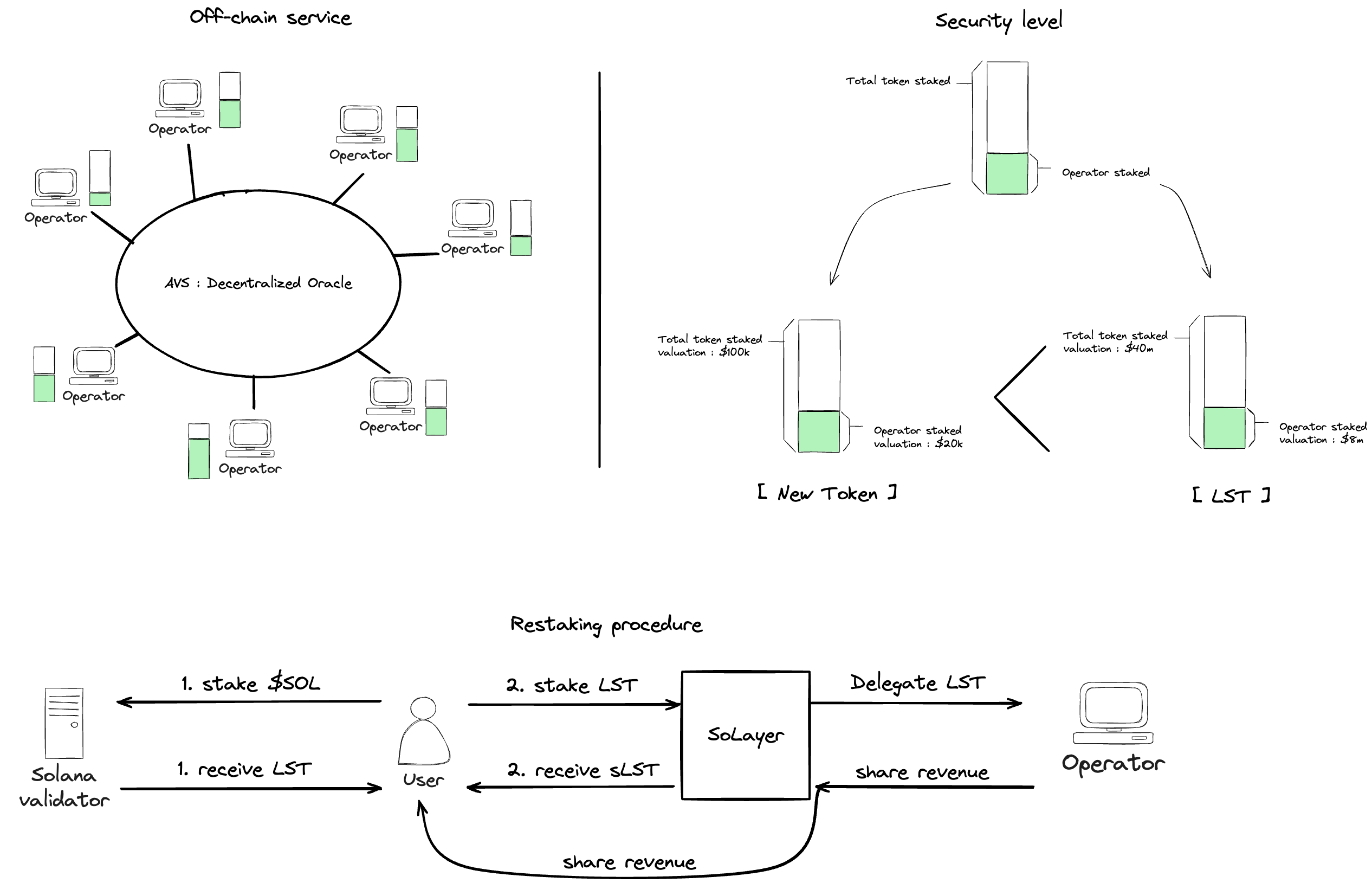
An off-chain service like oracle can get benefits from restaking. For instance, if a person operates a decentralized oracle service, then there are many operators involved; operators must reach an agreement on the oracle data. agreement in otherword consensus between operator are needed and PoS will be commonly used method. Building PoS algorithm leads to launching a new token. However, since new token launches may face cold start problems, it ends up taxing questions of economic value and trustworthiness of security that result from such tokens.
Such tokens, in their case, can be changed to LSTs. Operators stake Solana LSTs, involved in consensus, maintaining the security by risking their staked LSTs. In case of misbehavior, there is slashing of their staked LSTs. The operators are trying not to get their stakes slashed. Thereby, such an environment is created where the oracle brings more accurate information on-chain. This way, Solana protocol security can be utilized by off-chain oracle services.
Services acquired through the means of restaked tokens are called Actively Validated Services. Solayer supports Staking and Restaking of Solana, Marinade Staked SOL, Jito Staked SOL, BlazeStake Staked SOL, Infinity, and SolanaHub Staked SOL. All restaking by Solayer does more than delegate security to exogenous services—off-chain AVS.
Staking Widening the Road for Transaction Execution
SWQoS enables more virtual stake for RPC nodes that are peered with highly staked validators, allowing for more QUIC connections with the leader validators and hence the capacity to send more packets. Solayer uses restaking not only for exogenous services but also for endogenous services with SWQoS, further allowing on-chain Solana Dapps to benefit from restaking. In contrast to Ethereum's Eigen Layer, Solayer increases the potential of restaking to fit the Solana ecosystem.
The idea is simple: the more a Dapp receives in LSTs through restaking, the faster its users can execute transactions via an expressway. Dapps can share additional revenue generated from this advantage with restakers, incentivizing restaking. This method of using restaking for traffic allocation does not tie to security, thus eliminating slashing risks and providing truly slashing-free restaking. This contribution is immensely valuable, far beyond offering extra rewards for stakers on Solana.

Helius, in a blog describing SWQoS, spoke of a "Stake War" era in which every protocol on Solana would run its own validator and compete for staking volumes. At the same time, Helius launched hSOL, becoming—with the most alluring staking rates—the validator with the largest staking volume. To address the concern that a single RPC with high stakes and control over traffic transmission can harm Dapps and retail users, Solayer employs restaking. While Helius does not currently harm users, hypothetically, validator groups or RPCs could monopolize the traffic expressway and pass on costs to users and Dapps.
Solayer provides an environment where Dapps can secure their traffic by sharing revenue with Solana stakers. This ensures that users benefit from the fastest transaction execution without needing to know the identity of the underlying RPCs. Basically, Solayer is building the infrastructure for a genuinely express-like highway so that everyone on the network can ride it.
Potential Future Work in Solayer
If Solayer's ambitious vision bears fruit, Solana might grow into a healthier ecosystem where spamming would become less significant, and the high rewards from participating in staking would motivate more users to stake, significantly improving network security. One challenge remains: how to conditionally validate off-chain node peer relationships among validators and RPCs on-chain. This might be resolvable by using restaking volumes as quantitative metrics to guide stakers' choices for RPC nodes. These ideas, however, are still dubious in terms of their full feasibility.
Solayer should clarify whether it will operate the restaking RPC nodes itself or in collaboration with others and how it will verify the prioritization of transactions from certain Dapps. Without proving a proportional correlation between the transactions from Dapps and their restaking amounts in terms of network connections, trust in Solayer may fade.
LSTs are already staked in validators, and simply holding large amounts of LST does not impact SWQoS. The real question now is if Solayer can provide virtual stake equivalent to the Sol amount of restaked LST to the RPC nodes within its infrastructure. For example, if a Dapp receives restaking from Jito Staked SOL, but Solayer cannot secure virtual stake from the Jito validator, the Dapp will effectively lose network connections.
While Solayer has only published a lite paper on the development of their system, such issues need to be addressed for it to become a substantial infrastructure on Solana. Transparency over how Solayer allocates virtual stake to RPC nodes and ensures transaction prioritization based on restaking volumes is crucial for building trust and realizing their vision.
Conclusion
Solayer is an interesting player with a vision of how to make the Solana ecosystem better as a whole through restaking, or SWQoS mechanisms for advanced transaction processing and increasing network resilience. That said, one of its main goals is to be able to come up with a system wherein both exogenous and endogenous services are in a position to benefit from restaking, allowing for access to network resources to be decentralized and democratized.
There are, however, a number of key challenges that need to be overcome for this vision to be realized: on-chain validation of off-chain relationships, proof of the correlation between restaking volumes and network connections, and transparency in operations. Given it disentangles these challenges, Solayer will indeed do much to make a more secure, efficient, and fair Solana network, thus fulfilling the goal of building an expressway for everyone.










 Go back
Go back